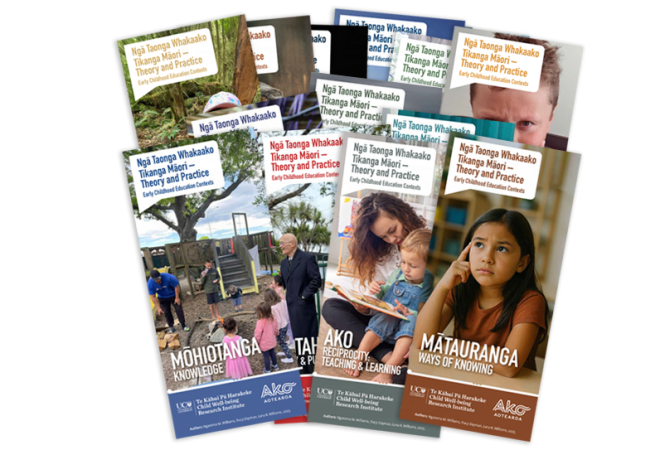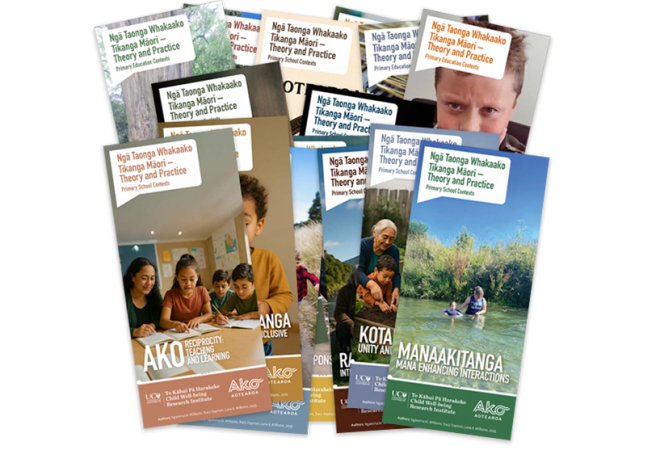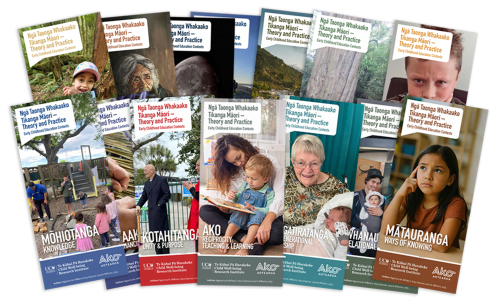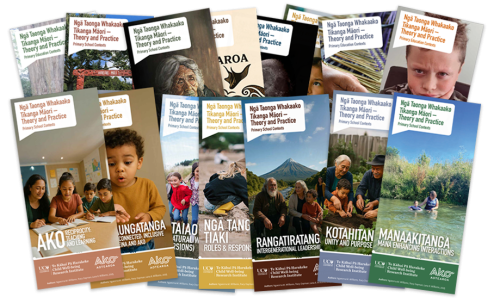

Ngā Taonga Whakaako Tikanga Māori | Theory to Practice
About the Collection
These two resource sets are a refreshed offering of the Ngā Taonga Whakaako resources, which aim to strengthen bicultural competence in early childhood education and primary schools by embedding tikanga Māori as lived, relational practice.
The goal is to enhance educators’ confidence and capability to teach and learn through mātauranga Māori, fostering environments where te reo Māori me ōna tikanga are normalised and valued alongside other knowledges.
Published: November 2025
Background
Ngā Taonga Whakaako: Bicutural competence in early childhood education was a project led by Ngaroma Williams (2012). A set of 10 resources introducing tikanga Māori principles (with definitions and examples of these in practice) were developed to support teachers to articulate their daily tikanga practices.
In 2025 Ngaroma has lead a team to provide a refreshed set of 15 tikanga Māori principles and examples of these in practice within the ECE and Primary School contexts. A strong focus of these resources is based on place-based education, local curriculum, Kaitiakitanga and teachers being confident in their cultural competencies as outlined in Tātaiako: Mārama, Mōhio and Mātau.
Authors
- Ngaroma Williams – University of Canterbury
- Tracy Dayman – University of Canterbury
- Lana Williams – Te Whare Wānanga o Raukawa
Key Points to Note:
The refreshed Ngā Taonga Whakaako resources extend bicultural competence development across early childhood and primary education, positioning tikanga Māori as foundational to teaching and learning.
Informed by kaupapa Māori methodology, the approach emphasises ako as a reciprocal, relational process that connects kaiako, ākonga, and iwi. Building on Williams and Broadley (2012), these renewed resources integrate local curriculum, contemporary classroom examples, and culturally grounded pedagogies that nurture confident, connected, and culturally responsive learners.
The methodology integrates:
- Kaupapa Māori principles – grounding the work in manaakitanga, whanaungatanga, rangatiratanga, and ako as guiding values.
- Co-construction with kaiako and iwi – ensuring local tikanga and narratives shape each resource.
- Reflective and dialogic practice – encouraging kaiako to explore personal positioning, assumptions, and responsiveness to Te Tiriti o Waitangi.
- Maramataka-informed design – aligning learning sequences and reflective phases with natural and cultural rhythms.
- Iterative renewal – building on Williams & Broadley (2012) by updating exemplars, language, and contexts to reflect current ECE practice and iwi partnerships.
Resource sets
There are two sets of 15 PDF resources. One focussed on Early Childhood Education Contexts and the other for Primary School Contexts.
The PDF files can be printed, double-sided, on A4 paper and folded to make a quick reference brochure.

|

|
Ngā Taonga Whakaako Tikanga Māori | Theory to Practice – Early Childhood Education Contexts |
Ngā Taonga Whakaako Tikanga Māori | Theory to Practice – Primary School Contexts |
This set of 15 brochures are a refreshed offering of the Ngā Taonga Whakaako resources, which aim to strengthen bicultural competence in early childhood education by embedding tikanga Māori as lived, relational practice.
Created by: Ngaroma Williams, Tracy Dayman and Lana Williams (2025)
- 28 November 2025
This set of 15 brochures are a refreshed offering of the Ngā Taonga Whakaako resources, which aim to strengthen bicultural competence in Primary school education contexts by embedding tikanga Māori as lived, relational practice.
Created by: Ngaroma Williams, Tracy Dayman and Lana Williams (2025)
- 28 November 2025
A project to explore the bicultural competence of early childhood teachers within Aotearoa-New Zealand and develop bicultural teaching and learning tools for New Zealand early childhood teachers.
Project
Ki Te Hoe: Indigenising Practice
A project that focusses on honouring indigeneity within the mandated bicultural early childhood curriculum Te Whāriki (Ministry of Education, 1996, 2017).
Cultural Capability Resource
Ki te hoe | Indigenising Spaces – Preparing teaching spaces in using and teaching te reo Māori
These resources have been developed to support kaiako/teachers across all sectors towards meeting their professional responsibilities of achieving te reo Māori competence within English-medium settings.